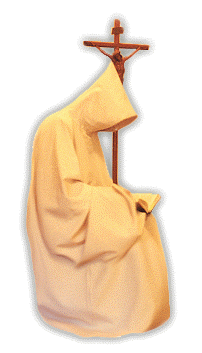Christian cenobitic monasticism started in Egypt. Originally, all Christian monks were hermits, and this continued
to be very common until the decline of Syrian Christianity in the late Middle Ages. But not everybody is well suited for the solitary
life.
For those who were not able to live the solitary life of a hermit, a need for some form of organized spiritual guidance
was required. Seeing this need around the year 300 Saint Anthony the Great started to organize his many followers
in what was to become the first Christian monastery. Soon the Egyptian desert abounded with similar institutions. Within a
generation, both solitary and communal monasticism became very popular and spread outside of Egypt, first to Palestine and
the Judean Desert and thence to Syria and North Africa. Saint Basil of Caesarea codified the precepts for these eastern monasteries
in his Ascetic Rule, or Ascetica, which is still used today in the Orthodox Church.
In the West the rules for monastic communities were not formalized until a few generations later, around the year
500, by Saint Benedict of Nursia who created the Rule of Saint Benedict at his monastery in Monte Cassino, it would
become the most common rule throughout the Middle Ages.
St Benedict commends the Rule of St Basil and alludes
to further authorities within the Rules he is credited with writing. He was probably aware of the Rule written by Pachomius;
and his Rule also shows influence by the Rules of St Augustine and St John Cassian. Benedict's greatest debt may be to
the anonymous Rule of the Master, of which his Rule seems to be an expanded, revised and corrected version
based on his own experience. The Rule of both St Augustine and St. Benedict are still used today.
The Carthusian Order, also called the Order of St Bruno, is
an enclosed Christian religious order founded by St. Bruno in 1084. There exist both Carthusian monks and nuns. They follow
their own Rule, called the Statutes, and combine eremitical and cenobitic monastic life. Carthusians are sometimes
considered the highest order of the Catholic Church, in terms of strictness. The motto of the Carthusians is "Stat crux
dum volvitur orbis" meaning "The Cross is steady while the world is turning".
The Community of Hermits
of St. Bruno was established in February 2001 to cater for men, women, clergy, and former religious who feel called to live
the eremetical life in their own hermitage, but with advantages of belonging to a Religious Comunity. The community follows
the Carthusian spirit and has the support of the Carthusian Prior at Parkminister, St Hugh's Charterhouse in England.
The
Immaculate Heart of Mary’s Hermitage was established in January 2001. In October of 2005 the hermitage that follows
the Carthusian spirit became associated with the Benedict Center and on April 2006 joined the Community of Hermits of Saint
Bruno as an eremitic member. On 13 May, the Feast of Our Lady of Fatima, in the year of Our Lord 2006 the Immaculate
Heart of Mary’s Hermitage obtained a permanent hermitage and opened it with the Apostolic Blessings of His Holiness
Pope Benedict XVI.

